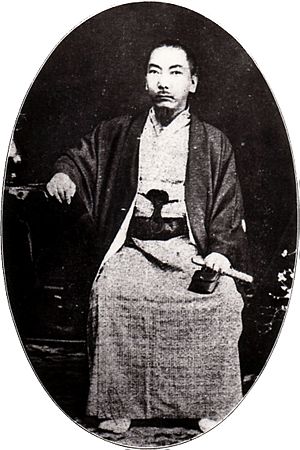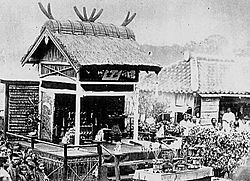Shō Tai facts for kids
Quick facts for kids Shō Tai尚泰 |
|||||||||
|---|---|---|---|---|---|---|---|---|---|

King Shō Tai
|
|||||||||
| King of Ryūkyū | |||||||||
| Reign | 8 June 1848 – 11 March 1879 | ||||||||
| Predecessor | Shō Iku | ||||||||
| Successor | None (Collapse of Ryukyu Kingdom) |
||||||||
| Regent | Nakijin Chōfu (1875–79) | ||||||||
| Member of House of Peers | |||||||||
| In office | 29 November 1890 – 19 August 1901 | ||||||||
| Successor | Shō Ten | ||||||||
| Born | Umijirugani (思次良金) 3 August 1843 Shuri, Ryukyu Kingdom |
||||||||
| Died | 19 August 1901 (aged 58) Tokyo, Japanese Empire |
||||||||
| Burial | Tamaudun | ||||||||
| Spouse | Omomatsurugane, Sashiki Aji-ganashi | ||||||||
| Concubine |
See list
Matsurugane, Matsukawa Aji
Matsurugane, Hirara Aji Yamamoto Teu Kataya Tei Matsumoto Kō Tanaka Kō Kanda Natsu Tanaka Hana |
||||||||
| Issue |
See list
Shō Ten, Crown Prince of Ryūkyū
Shō In, Prince Ginowan Chōkō Prince Shō Kō Shō Jun, Prince Matsuyama Shō Shū, Prince Tamagusuku Shō Shū Matsurugane, Princess Tsukayama Manabetaru, Princess Amuro Princess Makishi Princess Kadekaru Shō Higari Shō Toki Masako (Kanna Kenwa's wife) Yaeko (Tō Issen's wife) Chiyoko Kimiko Sayoko Suzuko Sadako |
||||||||
|
|||||||||
| Yamato name | Chōken (朝憲) | ||||||||
| House | Second Shō dynasty | ||||||||
| Father | Shō Iku | ||||||||
| Mother | Gentei, Sashiki Aji-ganashi | ||||||||
Shō Tai (born August 3, 1843 – died August 19, 1901) was the very last king of the Ryukyu Kingdom. He ruled from June 8, 1848, until October 10, 1872. After that, he was the head of the Ryukyu Domain until March 27, 1879. During his time as king, the Ryukyu Islands had more contact with visitors from Europe and the United States. His reign also saw the end of the Ryukyu Kingdom. It became part of Japan, first as the Ryukyu Domain, and later as Okinawa Prefecture. In 1879, King Shō Tai was asked to move to Tokyo. Later, in 1885, he was given the title of Kōshaku, which means Marquess. This was a high rank in the Japanese noble system.
Contents
Becoming King and Early Years
Shō Tai became King of Ryukyu when he was only six years old. He ruled for almost 31 years. The first 10 to 20 years of his rule were mostly about how the kingdom dealt with Western countries. These countries wanted to open up trade, have formal relations, and allow their people to visit and live in the Ryūkyū Islands.
Westerners had visited the Ryukyu Islands for many years before Shō Tai became king in 1848. They were usually welcomed and given supplies. But it wasn't until the 1850s that official rules allowed trade and relations with Europeans and Americans. An important American, Commodore Matthew C. Perry, visited Naha several times. He came before and after his famous visit to Japan in 1853. Perry was never allowed to meet the young King Shō Tai, even though he asked to. He did meet with the King's regent and other important officials. This led to the Lew Chew Compact in 1854. This agreement, like the one Japan signed, opened Ryukyu to trade with the United States. Soon, other Western countries also started trading with Ryukyu. The lord of Satsuma Domain, Shimazu Nariakira, supported this. He thought it would bring wealth and power. Ryukyu had especially strong ties with France. A French group even gave some field artillery to Shō Tai in 1857.
In 1858, Nariakira died. His half-brother, Shimazu Hisamitsu, took over. Shō Tai had to promise his loyalty to the Shimazu clan again, just as his ancestors had done since 1611. Hisamitsu changed his brother's policies. He was against foreign influence, which affected Japan in the next ten years.
In 1864, after Shō Tai had been king for 16 years, a traditional mission was sent to China. This mission formally asked the Chinese Emperor to officially recognize Shō Tai as king. Two years later, Chinese representatives came to Ryukyu. They officially recognized Shō Tai's rule on behalf of the Tongzhi Emperor.
Japan's New Government and Ryukyu
In 1868, Japan went through a big change called the Meiji Restoration. Four years later, the old feudal system in Japan was ended. This made the relationship between the Ryukyu Kingdom and Japan's new government unclear. Shō Tai and his advisors were never asked for their opinions.
Around the same time, in 1871, a Ryukyuan ship crashed on the coast of Taiwan. The local people there killed its crew. The Satsuma region pressured Shō Tai to ask Japan's government for help. This event became a big international issue. It eventually led to Japan sending soldiers to Taiwan in 1874. To solve this problem and others about Ryukyu's relationship with Japan, Shō Tai was told to go to Tokyo. There, he was supposed to formally show his respect to Emperor Meiji. This would mean that he and his kingdom were under the Japanese Emperor. Shō Tai said he was sick and couldn't go. Instead, he sent his uncle, Prince Ie, and Ginowan Ueekata, an important minister. In Tokyo, these envoys were given a message for their King. It said that the kingdom was now "Ryukyu Han". This meant it was a feudal area under the Japanese Emperor, like other areas in Japan that had just been changed. This new plan meant Ryukyu was no longer under Satsuma. But it also meant it was now part of Japan and under the government in Tokyo.
Two visits by Matsuda Michiyuki, a top official from Japan's Home Ministry, happened in 1875 and 1879. These visits aimed to change how Ryukyu was run. Shō Tai and some of his main ministers were given official ranks in the Japanese Imperial Court. The King was ordered to come to Tokyo in person. Again, he said he was sick. Prince Nakijin led a small group of officials to thank the Japanese government instead. However, the King's refusal to come to Tokyo and his continued direct talks with China worried Japan's new leaders. In 1878, Home Minister Itō Hirobumi made plans to end Ryukyu's special, partly independent status.
End of the Kingdom and Life in Tokyo
On March 27, 1879, Shō Tai officially gave up his throne. This happened because Tokyo ordered it. The Japanese government ended Ryukyu han and created Okinawa Prefecture. Officials from Tokyo were sent to govern the islands. The former King had to leave his palace. He did so on March 30. He was then told to move to Tokyo. After some delays, again saying he was sick and couldn't travel, he finally left Okinawa on May 27. He arrived in Yokohama on June 8. From there, he traveled with 96 people from his court to Tokyo.
On June 17, 1879, Shō Tai met with Emperor Meiji. He was then made part of the new kazoku noble class. On May 2, 1885, he was given the title of Marquess (kōshaku). A Chinese official named Li Hongzhang protested against Japan taking over the former kingdom. He tried to discuss Ryukyu's independence with former US president Ulysses S. Grant and Japanese officials. But he was not successful.
A Japanese statesman, Ōkubo Toshimichi, suggested in 1875 that if Shō Tai became the permanent governor of Okinawa, it would help calm people in Okinawa who were against Japan. It would also help Okinawa become more a part of Japan. A big Okinawan group called the Kōdō-kai suggested the same idea later. But Tokyo rejected it. They thought it might make it seem like the current government had failed. It could also bring back questions about who owned the islands.
Even though he was now a Marquess, many of the old customs and ceremonies for the Ryukyuan King were still done for Shō Tai. He moved in the important social circles of Tokyo and became involved in business. His family tried to start a copper mining business in Okinawa in 1887, but it didn't do well. However, his business managers did create a company in Osaka called "Maruichi Shōten". This company sold traditional Okinawan products in Osaka and all over Japan. Shō Tai only returned to Okinawa Prefecture once in the rest of his life. That was in 1884, to pay his respects to his ancestors at Tamaudun, the royal burial place in Shuri.
Shō Tai died in 1901 when he was 58 years old. He was buried in the royal burial place at Shuri, Tamaudun. His family followed traditional Ryukyuan mourning customs for two years. After that, they stopped wearing traditional clothes, doing old rituals, and speaking the old court language. They adopted the ways of the rest of the Japanese kazoku nobility.
See also
 In Spanish: Shō Tai para niños
In Spanish: Shō Tai para niños



